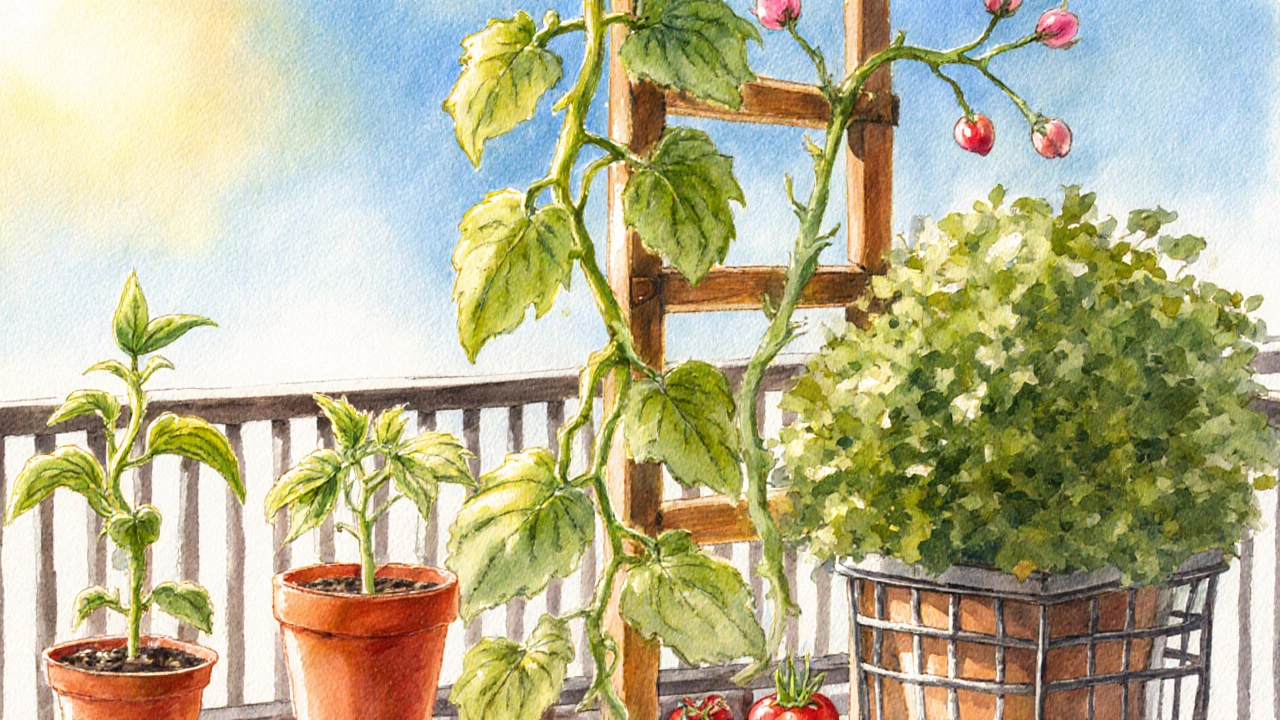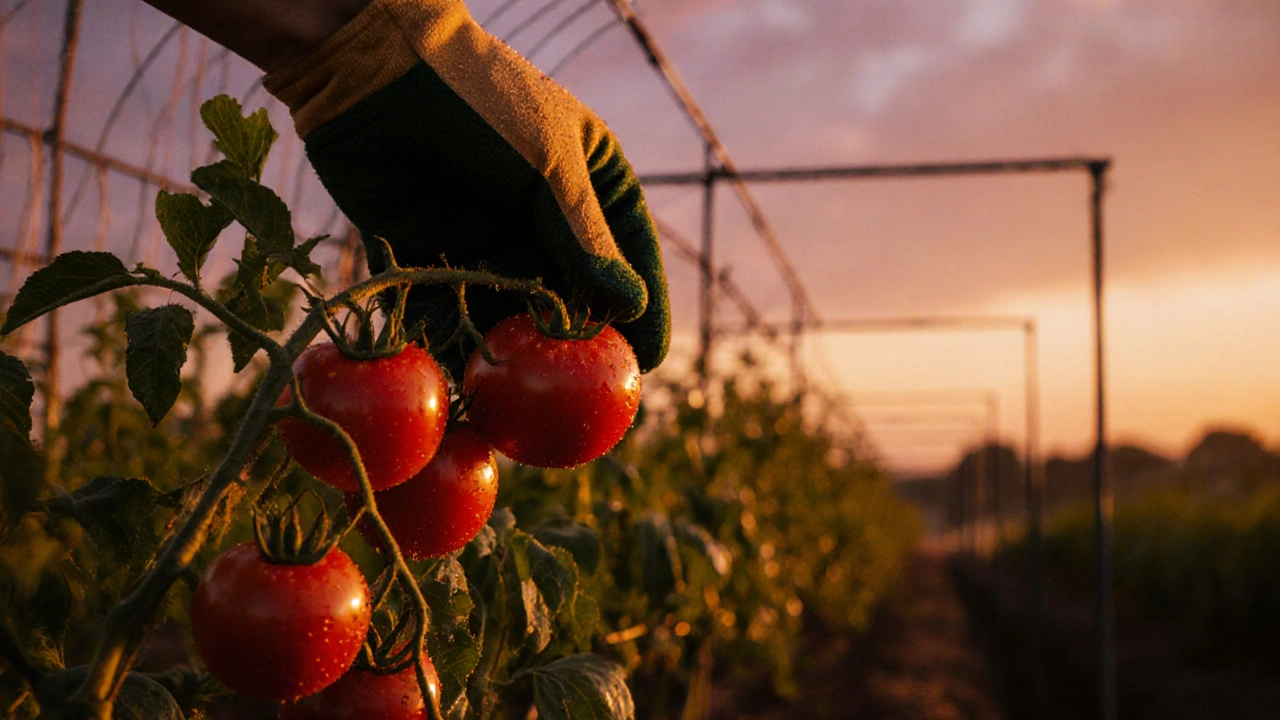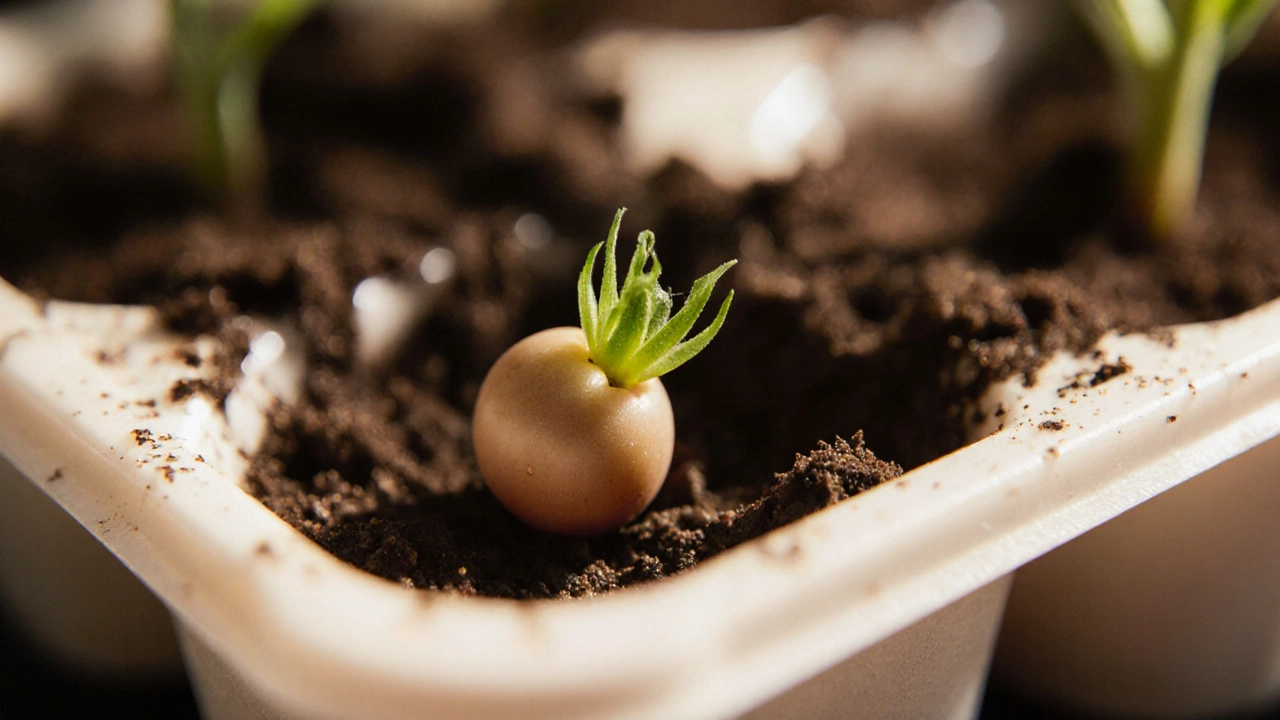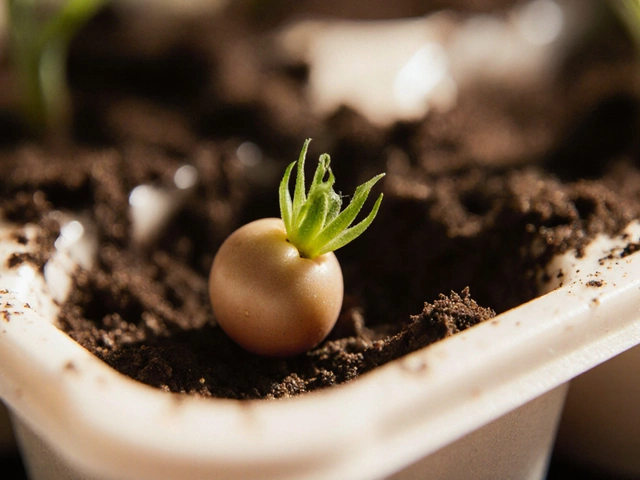Tomato Growth Calculator
Set Your Parameters
Why This Matters
Understanding growth timelines helps you plan your garden, avoid missed harvests, and optimize growing conditions for each tomato variety.
Growth Timeline Results
Key Milestones
0% Complete
Ever wondered why some gardeners brag about fresh tomatoes on the balcony while others stare at tiny green shoots for weeks? The answer lies in the growth timeline - a mix of biology, weather, and a few savvy tricks. This guide walks you through every stage, from seed to salad, so you know exactly how long to expect each step to take.
What a Tomato Really Is
Tomato is a warm‑season fruit (botanically a berry) that belongs to the nightshade family. Its scientific name, Solanum lycopersicum, hints at its close relatives like potatoes and eggplants.
Growth Stages at a Glance
Breaking the life cycle into bite‑size phases helps you track progress and spot problems early.
- Germination: Seed absorbs water, swells, and cracks open. Usually 5-10 days under 70‑80°F (21‑27°C).
- Seedling: First true leaves appear. 2-3 weeks after germination if light is adequate.
- Transplant: Move the young plant outdoors or into a larger pot. Best when seedlings have 2-3 true leaves and nighttime temps stay above 50°F (10°C).
- Vegetative growth: Stems & foliage expand. 4-6 weeks, depending on variety and conditions.
- Flowering & fruit set: Small yellow blooms appear, then tiny green fruit form. 2-3 weeks after the plant reaches full leaf canopy.
- Fruit maturation: Green fruit turns red (or yellow, orange, purple depending on the cultivar). 45-70 days from pollination to ripe tomato.
Key Factors That Speed Up or Slow Down Growth
Not all tomatoes grow at the same pace. Here’s what really matters:
- Variety type: Determinate (bush) varieties usually finish fruiting in 60-70 days from transplant. Indeterminate (vining) types keep producing for 120+ days.
- Temperature: Optimal daytime 70‑85°F (21‑29°C). Below 55°F (13°C) growth stalls; above 95°F (35°C) plants may set little fruit.
- Sunlight: At least 6-8 hours of direct sun daily. Less light = leggy stems and slower fruit development.
- Soil quality: A well‑draining mix with pH 6.0‑6.8. Heavy clay holds water, leading to root rot and sluggish growth.
- Watering: Consistent moisture, not soggy. Irregular watering causes blossom‑end rot and can stress the plant, extending the timeline.
- Fertilizer: Balanced N‑PK (10‑10‑10) starter feed, then switch to a formula higher in potassium (5‑10‑10) once fruit sets.
- Pruning & staking: Removing suckers on indeterminate vines directs energy to fruit rather than excess foliage.
Typical Timelines for Popular Varieties
Below is a rough calendar based on UK climate (Brighton‑type weather). Adjust a week earlier or later depending on your micro‑climate.
- Cherry tomatoes (e.g., ‘Sweet Million’ - indeterminate): 55-65 days from transplant to first ripe fruit.
- Roma (determinate): 70-80 days from transplant.
- Beefsteak (indeterminate): 80-95 days.
- Heirloom ‘Brandywine’ (indeterminate): 90-110 days.

Month‑by‑Month Calendar for a Brighton Gardener
- February: Start seeds indoors on a heated mat (70°F/21°C). Use seed‑starting mix and keep under grow lights.
- March: Once seedlings have two true leaves, thin to strongest plant. Begin hardening off on a sunny windowsill.
- April: After the last frost (usually early April in Brighton), transplant seedlings outdoors into raised beds or large pots. Space determinate plants 18‑24 inches apart; indeterminate 24‑36 inches.
- May: Mulch, install stakes or cages, and start a regular watering schedule. First flowers appear.
- June: Fruit set begins. Apply potassium‑rich fertilizer every 2 weeks.
- July-August: Harvest begins for early varieties. Continue pruning indeterminate vines to remove side shoots.
- September: Late‑season varieties keep producing. Start feeding with a balanced liquid fertilizer.
- October: Harvest the last ripe fruits before frost. Remove plants and compost healthy leaves.
How to Speed Up Growth Without Cutting Corners
These tricks shave days off the timeline while keeping plants healthy:
- Use a clear plastic tunnel or mini‑greenhouse to raise night temps by 5-10°F (3-6°C) during early weeks.
- Apply a coffee‑ground mulch to boost nitrogen early, then switch to straw or straw‑chopped leaves for water retention.
- Feed a low‑dose liquid fertilizer (e.g., 1‑2 ml per litre) every week once seedlings have true leaves.
- For indoor starts, set lights 2-3 inches above the tops and raise them weekly to avoid stretching.
- Pinch the first set of true leaves on seedlings to encourage a bushier habit.
Common Pitfalls and Quick Fixes
Even seasoned growers hit a snag. Here’s how to recover fast:
- Slow growth after transplant: Check soil temperature; if below 60°F (16°C), add black plastic mulch to warm it.
- Leggy, weak stems: Move plants to a sunnier spot or add supplemental grow lights.
- Blossom‑end rot: Ensure even watering, avoid over‑fertilizing with high nitrogen, and mulch to keep soil moisture stable.
- Bolting (premature flowering): Provide shade during the hottest part of the day and keep night temps cool.

Determinate vs Indeterminate: Quick Comparison
| Aspect | Determinate (Bush) | Indeterminate (Vine) |
|---|---|---|
| Growth habit | Compact, stops growing after fruit set | Continues vegetative growth throughout season |
| Typical days to maturity | 60‑70 days from transplant | 80‑120+ days from transplant |
| Fruit production | One large flush over 2‑3 weeks | Steady harvest over many months |
| Support needed | Small cages or stakes | Sturdy trellises or tall cages |
| Best for | Container growers, short season gardens | Large gardens, growers who want continuous supply |
Quick Harvest Checklist
- Seed started: 5‑10 days after sowing
- Seedlings ready for transplant: 2‑3 weeks
- First flowers appear: 4‑5 weeks after transplant
- First ripe fruit: 45‑70 days after pollination (variety dependent)
- Peak harvest window: 6‑8 weeks for determinate, 10‑14 weeks for indeterminate
Frequently Asked Questions
How long does it take for a tomato seed to sprout?
Under ideal temperature (70‑80°F / 21‑27°C) and constant moisture, most tomato seeds break dormancy in 5 to 10 days.
When should I transplant seedlings outdoors in the UK?
Wait until night temperatures stay above 50°F (10°C) and any risk of hard frosts has passed - typically early to mid‑April for coastal areas like Brighton.
Do determinate tomatoes really finish earlier?
Yes. They usually stop setting new fruit after about 2‑3 weeks, reaching full maturity 60‑70 days after transplant.
How can I tell if my tomato plant is ready to harvest?
Pick a fruit that has fully changed color (red, orange, yellow depending on the cultivar) and feels firm but yields slightly to gentle pressure. A slight smell of sweetness is a good sign.
Why are my tomatoes turning yellow before they ripen?
Yellowing can indicate nutrient imbalance (too much nitrogen) or inconsistent watering. Reduce nitrogen feed, keep soil evenly moist, and ensure full sun exposure.
Can I grow tomatoes inside during winter?
Yes, with grow lights, a warm spot (70°F/21°C), and proper ventilation. Expect a longer cycle - roughly 90‑110 days from seed to harvest.
With the timeline laid out, you can plan your sowing, caring, and harvesting steps confidently. Remember, every garden is a little different, so use this guide as a framework, not a rigid rule. Happy planting and enjoy those fresh, home‑grown tomatoes!


